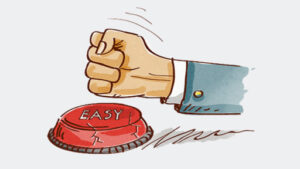
Judge Your Decisions, By Your Decisions.
At the risk of this post sounding like a book review, I
Share this post
For today’s Psych Saturday post, I’d like to discuss risk. I think traders are in a relatively small group of people who actually think about risk on a regular basis, and many (but certainly not all!) of them actually have a very good handle on risk and how to measure it.
The well-known author and psychologist (in that order I would say) Dr. Alexander Elder wrote something in one of his books that struck me very hard the first time I read it, and stuck with me to the point that I repeated the essence of it many times, including to new traders who were coming to me for input and advice.
Dr. Elder writes:
Certainty exists only in the middle of the chart; it does not live at the right edge. A fruitless search for certainty is the undoing of many educated traders who think they will reach clarity if only they work hard enough. Whenever you enter a trade, you face two risks – a money risk and an information risk. The pros are comfortable with uncertainty, as long as their financial risk is low. Beginners, on the other hand, keep waiting for more confirmations and end up risking a lot more money.
– Dr. Alexander Elder
To illustrate this in a terribly over-simplified way, imagine a typical intraday “double top”. Price made a high in the morning and pulled back from it. Then it gets very close to that same level again after say an hour. The trader is quite sure that this trade will likely not go higher since it’s a double top, so they put on a short at the high, and place their stop maybe 2 to 5 points away.
Ignoring for a moment whether or not this trade was a good idea at all, it’s an example of “monetary risk, not information risk”. The trader believes (wrongly, I would argue… but we’ll get to that) that his information is solid. It’s a double top, so it has to reverse. But he needs to “give it room to work” and so accepts a $100 to $500 risk per contract (I’m imagining trading ES in this example).
Now instead, imagine that same scenario but this time, price has already pushed through the double top and gone say 8 ticks higher. A different trader sees this and using order flow analysis and statistical probabilities, is able to gauge the strength of this push higher and determines that there is a good probability of it heading lower. This trader gets short with say 3 ticks ($37.50) of risk instead. This is an example of “information risk, not monetary risk”, the trader knows they could still be wrong but they have some things working for them that the first trader did not, and if they are wrong anyway the risk to their capital is very small.
Here is the part I find so interesting, and has been a massive shift in my own thinking and approach to my trading. I no longer absolutely believe what Dr. Elder wrote above, because I now know that it is actually possibly to have both low information risk, and low monetary risk. The trader in the second example above, demonstrated that.
This is not to say that it is possible to have this “low risk” situation in every single trade every time. Sometimes the markets are just not clear, and you have to be OK with a bit of the unknown. But I do still think it’s valuable to think in terms of what you’re risking. Maybe ask yourself “Am I taking information risk or monetary risk with this trade?” If the answer is “monetary risk” then you might want to reconsider, or look for a better entry.
The primary value for me of understanding how to read order flow, has been acquiring the information I can use, to lower my risk. Understanding who is buying, when, and where, gives you insights into the risk of a particular entry that are simply not possible at all when looking at a conventional bar or candlestick chart. It allows you to fill in the information gap before taking a trade, and gives the very regular potential for risk in the single-ticks, and often less than a point in ES.
The other side of risk assessment that has been priceless for me, is understanding the probability of occurrence of certain events. For instance in the first trade example I wrote above with the double top. What the first trader failed to understand, and that the second trader capitalized on, was that there are certain behaviors in a market like ES that we can measure for their frequency of occurrence, and therefore make sure that we’re on the right side of those events. One of these is based around the idea of the first hour’s range, and the probability of that range breaking. The first trader didn’t know what a terrible idea it was to fade that first re-test of the morning’s high. The second trader not only knew that was a bad idea, but also knew that they could quantify the strength of the break, and from there know what the probability was of a trade in the opposite direction being a good idea.
There is certainly randomness in the markets, but they are not just completely random. And while there is risk inherent in everything we do as traders, a deeper understanding of the inner workings of the buyers and sellers in a given market, can go a very long way to mitigating our danger in this otherwise very risky business.
Until next time, trade well!
Jonathan van Clute
Community Manager, Trading Research Group
Share this post
You Might Also Be Interested In:

At the risk of this post sounding like a book review, I

As I write this, it’s mere hours away from the clock striking

Well seeing as how it’s “the day after Black Friday” in the

There is a risk of loss in futures, forex and options trading. There is risk of loss trading futures, forex and options online. Please trade with capital you can afford to lose. Past performance is not necessarily indicative of future results. Nothing in this site is intended to be a recommendation to buy or sell any futures or options market. All information has been obtained from sources, which are believed to be reliable, but accuracy and thoroughness cannot be guaranteed. Readers are solely responsible for how they use the information and for their results. Trading Research Group does not guarantee the accuracy or completeness of the information or any analysis based thereon.
Hypothetical performance results have many inherent limitations, some of which are described below. No representation is being made that any account will or is likely to achieve profits or losses similar to those shown; in fact, there are frequently sharp differences between hypothetical performance results and the actual results subsequently achieved by any particular trading program. One of the limitations of hypothetical performance results is that they are generally prepared with the benefit of hindsight. In addition, hypothetical trading does not involve financial risk, and no hypothetical trading record can completely account for the impact of financial risk of actual trading. for example, the ability to withstand losses or to adhere to a particular trading program in spite of trading losses are material points which can also adversely affect actual trading results. There are numerous other factors related to the markets in general or to the implementation of any specific trading program which cannot be fully accounted for in the preparation of hypothetical performance results and all which can adversely affect trading results.
This presentation is for educational purposes only and the opinions expressed are those of the presenter only. All trades presented should be considered hypothetical and should not be expected to be replicated in a live trading account.
Testimonials and reviews appearing on this website may not be representative of other clients or customers and is not a guarantee of future performance or success.
© 2022 Make Ticks LLC dba Trading Research Group. All rights reserved. TickMaker™ is a trademark of Make Ticks LLC.